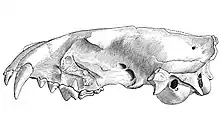| Paraenhydrocyon Temporal range: | |
|---|---|
 | |
| Skull of Paraenhydrocyon josephi | |
| Scientific classification | |
| Domain: | Eukaryota |
| Kingdom: | Animalia |
| Phylum: | Chordata |
| Class: | Mammalia |
| Order: | Carnivora |
| Family: | Canidae |
| Subfamily: | †Hesperocyoninae |
| Genus: | †Paraenhydrocyon Wang, 1994 |
| Type species | |
| †Temnocyon wallovianus | |
| Species | |
| |
Paraenhydrocyon ("beside Enhydrocyon") is an extinct genus of bone crushing omnivorous early canid which inhabited North America during the Early Miocene, 24.8—20.4 Ma, existing for approximately 5 million years. [1]
The dentition suggests that this animal was a hypercarnivore or mesocarnivore.[2] In addition to its retention of several primitive cranial characters, this includes unique sharp-tipped, slender premolars that clearly contrast with the strong premolars of the Mesocyon–Enhydrocyon group, but also parallels that clade by having a reduced metaconid cusp on the lower molars.
References
This article is issued from Wikipedia. The text is licensed under Creative Commons - Attribution - Sharealike. Additional terms may apply for the media files.